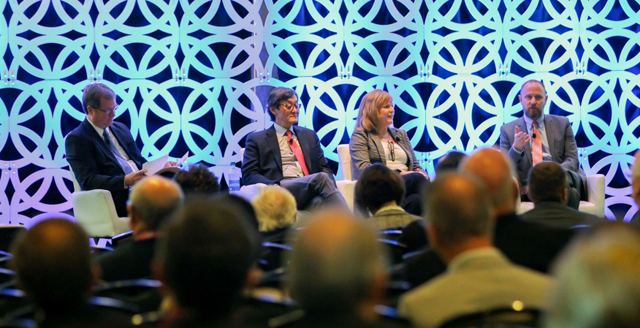The Long and Winding Last Mile: Improving Airport Ground Access
![]() Print this Article | Send to Colleague
Print this Article | Send to Colleague

Airports all over are struggling to address ground transportation difficulties. In the session “The Long and Winding Last Mile: Improving Airport Ground Access,” Mark Duebner, Director of Aviation, City of Dallas Department of Aviation, Margaret McKeough, EVP & COO, Metropolitan Washington Airports Authority and Howard Eng, President & CEO of the Greater Toronto Airports Authority discussed the different approaches their airports are using to tackle the influx of ground transportation obstacles.
Dallas Love Field began planning parking renovations back in 2009 before TNCs existed and before the impact of these services was known. As services like Uber and Lyft gained popularity and strained ground access, the team made changes to the planned layouts, Duebner said, to accommodate TNC pick-ups and drop-offs, including moving taxi cabs and doubling the amount of land space for TNCs. Ensuring smooth operations for all vehicles accessing the airport is an ever-evolving process and Dallas Love Field is still considering other options to keep vehicles flowing through the airport, including providing a second option for airport access from arterial roadways serving northern neighborhoods and linking to regional transportation corridors.
McKeough said that Dulles International Airport began addressing the issue of ground access to the airport years ago when airport operators had the foresight to reserve land to bring the metro system out to the airport to connect it to Washington D.C. in advance of needing it. McKeough explained that the issue Dulles faces is that infrastructure in Northern Virginia hasn’t kept up with the airport’s needs and the airport’s 12,000 acres straddle two counties and depends on government and state services to operate. To help ease this strain, MWAA offered to and currently manages both the Dulles Toll Road and construction of the metro expansion.
Toronto Pearson International Airport faces similar issues in being a multi-jurisdictional airport, said Eng. Roadway access and transportation is difficult in the area surrounding the airport. As the regional need for roadway access and transportation has grown, the airport has looked to public transportation to ease the strain and provide access to other points of interest throughout the region.
“An airport is never the final destination,” Eng said.
